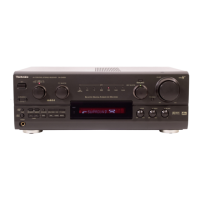
Do you have a question about the Technics SA-DX930 and is the answer not in the manual?
| Impedance | 8 ohms |
|---|---|
| Weight | 11.5 kg |
| Video Connections | Composite video input/output |
| Power Output | 100 watts per channel (8 ohms, 20 Hz - 20 kHz, 0.09% THD) |
| Total Harmonic Distortion | 0.09% |
| Input Sensitivity | 200mV |
| Tuning Range | FM, MW |
| Speaker Load Impedance | 8 ohms |
| Input Sensitivity/Impedance | 200 mV / 47k ohms (CD) |
Covers electrical safety, installation environment, and proper handling of the unit.
Guidelines for unit setup, optimal placement, environmental conditions, and cleaning.
Details on when to seek professional repair and user servicing limitations.
Lists all items included with the receiver for verification.
Guidance on battery installation, usage, and operational tips for the remote.
Explains Dolby Pro Logic, Dolby Digital, DTS, and SFC surround sound systems.
Details on the features and capabilities of Dolby Pro Logic, Dolby Digital, and DTS.
Power, input, speaker, sound mode, and tuning controls on the main unit.
Volume, tone controls, balance, and headphone jack on the main unit.
Display indicators, tape monitor, DSP/HELP buttons on the main unit.
Indicators for radio tuning status, sound modes, and input signals.
Indicators showing speaker status and surround sound formats.
Buttons for power, input selection, and mode selection on the remote.
Controls for surround modes, delay, level, and muting via remote.
Buttons for radio tuning, disc selection, and menu navigation.
How to connect turntables, tape decks, and VCRs using analog cables.
Details on AC outlet usage and the unit's cooling fan operation.
Using analog cables for satellite receivers, DVD, and CD players.
How to connect digital sources via coaxial or optical cables.
Precautions for using and storing optical fiber cables to prevent damage.
Instructions for installing the FM indoor antenna for best reception.
Guidance on mounting the AM loop antenna for optimal AM reception.
Using and installing an FM outdoor antenna for improved reception.
Guidelines for installing an AM outdoor antenna for better reception.
Optimal positioning recommendations for front and center speakers.
Recommendations for placing surround speakers and the subwoofer.
How to connect front speakers to the unit's terminals.
Connecting active/passive subwoofers and external power amplifiers.
How to correctly wire surround and center speakers to the unit.
Setting front speakers to LARGE or SMALL based on bass capability.
Setting center/surround speaker type or presence.
Finalizing speaker settings and saving them to memory.
How to turn the subwoofer channel output on or off.
Explains the display indicators for speaker status and output.
Steps to turn on the unit and select active speaker systems.
Choosing audio/video sources and digital/analog input types.
How to set the desired listening volume.
Adjusting for speakers with impedance under 8 ohms.
How to use the tape monitor for recording and playback.
Tuning radio stations and performing automatic station search.
Switching FM reception between stereo and mono for noise reduction.
Disabling DSP processing for clearer radio reception.
Using numeric buttons to tune to specific radio frequencies.
Automatically searches for and stores radio stations into memory.
How stations are stored, indicated, and managed.
Manually selecting channels and frequencies to store in memory.
How to recall and listen to stored radio stations.
Using Stereo and Surround modes for various audio sources.
Selecting DTS mode when Surround mode is not recognized.
Explains HALL, CLUB, LIVE, THEATER, and SIM SURR effects.
Disabling DSP and returning to Stereo mode for direct playback.
Setting individual speaker volumes for balanced apparent output.
Using test signals to check each speaker's output level.
Adjusting delay for the center speaker based on listening position.
Adjusting delay for surround speakers based on listening position.
Formula for setting center speaker delay based on distances.
Formula for setting surround speaker delay based on distances.
Choosing sources and sound modes like STEREO, SURROUND, DTS.
Choosing specific SFC modes like HALL, CLUB, LIVE, THEATER.
Setting individual speaker volume levels within SFC modes.
Fine-tuning delay time for surround speakers in SFC modes.
Adjusting bass, treble, and sound balance for tone quality.
Muting sound, listening via headphones, and subwoofer on/off.
Steps for recording audio to a tape deck.
Checking recorded sound using the tape monitor function.
Steps for recording audio/video to a VCR.
Buttons for power, input selection, and mode selection on the remote.
Outputting test signals and adjusting speaker levels/delay via remote.
Selecting FM/AM bands and channels sequentially or directly.
Starting playback, selecting discs/tracks, skipping, and stopping.
Controlling TV reception and channel selection using the remote.
Controlling VCR playback, fast-forward, rewind, and stop using the remote.
Controlling DVD playback, titles, menus, and chapters via the remote.
Steps to set remote control codes for different brands of TVs and VCRs.
Diagnosing and fixing hiss, noise, and distortion in FM reception.
Diagnosing and fixing hum, noise, and interference in AM reception.
Solutions for power failure, no sound, or overload display errors.
How to use the HELP function for operational guidance and error resolution.
Detailed technical data for amplifier, tuner, and radio sections.
Specifications for video, digital input, power supply, and weight.
Guidelines for protecting hearing from excessive volume exposure.
How to clean the unit safely and information on product service.
